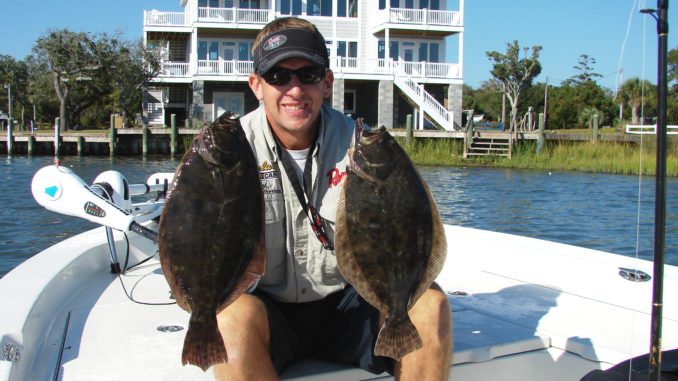
Live mullet minnows pitched under structure along route from marshes to inlets has been the ticket
Capt. Rick Patterson of Cape Crusader Charters isn’t a travel agent, but he sure keeps up with the travel schedules of flounder in the fall. This week, he knows they’re moving out of creeks in Carteret and Onslow counties and headed for the ocean – stopping along the way to feed around docks where he’s catching them.
Patterson, who is from Cape Carteret, heads for those docks as soon as he can fill his baitwell with mullet minnows. On a trip earlier this week, he picked docks along the waterfronts at Cedar Point and Swansboro, expecting the cooling weather to stoke up the action a little.
“When the flounder move out to the docks in the fall, they are feeding and aggressive,” Patterson said. “Unlike during the summer, the water has gotten cooler, and they know they are building some bulk for the winter. This is serious, and they don’t let much go by. If you get a bait close to them, they will usually try to eat it.”
Patterson (252-342-1513) rigged two medium-light spinning outfits with his modified version of a Carolina rig. This rig has limited travel of about a foot for the sinker and places a 2/0 Eagle Claw Trokar Lancet circle hook that combines the features of Kahle and circle hooks.
Easing close to a dock, Patterson set his Power Pole and threaded minnows through the nose onto hooks. One minnow was about three inches long and the other about five inches. He explained the difference as a way to see if the flounder had a preference – as they sometimes do. He then pointed out that when flounder like the smaller minnows, they can get them in their mouths so much easier and quicker and are easier to catch.
“Cast right up to and even a little under the dock,” Patterson said. “You need to be ready to drag one out and away from the dock as soon as you hook it. A big flounder will want to stay in the cover, and there are some schools of redfish that also hold in the same areas. You have to get them clear of the dock quickly or they will break you off.”
Patterson had barely finished his sentence when he leaned back to set the hook and dragged the fish out from under the dock. It broke the surface splashing water everywhere; Patterson proclaimed it a redfish, not a flounder.
The next several casts also produced fat mid- to upper-slot redfish. Finally, after several casts, the pickup was more subtle, not the runaway redfish freight train. Patterson dropped his rod tip for a few seconds and then brought it up quick and firm to set the hook on the first flounder.
The scenario was repeated often throughout the day. On only one dock did a flounder get in the first strike, but they were all keepers; no shorts tried to crash the party – a pretty good fishing trip for never leaving the docks.




Be the first to comment